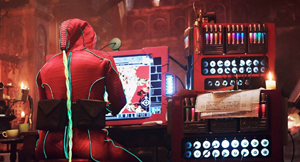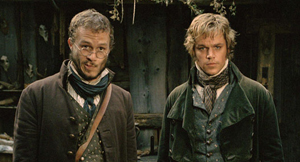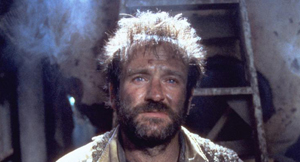
Bagpipers frustrating motorists on Edinburgh’s main street
In August 1998, Dreams spent a few days at the Edinburgh International Film Festival, since Terry Gilliam was there presenting the UK premiere of Fear and Loathing in Las Vegas. While he was there, he introduced the film, and also gave a two-hour Q&A session with jounalist Mark Kermode. Below is part one of the transcript of that Q&A session, and below that are more photos from Edinburgh.
Transcript of Gilliam’s Edinburgh 1998 Q&A – Part One
On how Terry Gilliam ended up making Fear and Loathing in Las Vegas…
TG: What happened was Alex Cox was the original director of this project. Johnny Depp and Benicio del Toro joined up along the way and Alex managed to alienate Hunter, Johnny, in fact everybody involved in the whole project and was then sent packing – this is all before my time. I remember sitting in a restaurant in London – the first I was aware of this Cameron Diaz’s manager mentioned they were looking for a director and Ralph Steadman called me and said “c’mon c’mon” and they sent me the script and I was in Italy and I didn’t read it for the week and a half I was there. I just didn’t want to think about it. I sat down one day, started reading it and it got me laughing and it immediately brought back the book. The beginning of the script, which was the script Alex wrote, was from the book and it’s wonderful it was funny WHAM you’re into this outrageous trip and I went on reading further because it just seemed to be about two guys on drugs behaving badly over a weekend with no redeeming features – no morality with no concern for anything but being outrageous. So I went back to the book and the book of course is much more reflective – underneath the surface of wild behaviour it’s actually quite a reflective book.
So I went out to LA and met Hunter Thompson and Johnny and Benicio, and we somehow managed to live together the next six months. We wanted to write a new script so Tony Grisoni (with whom I was working on something else) and I sat down and went to work and at the same time doubled the budget.
And it was an interesting process because the film already had a certain momentum, and the hardest thing getting films going is that initial momentum. Then when I got on board, it started rolling even faster towards the edge of the cliff. We were trying to finish the script, we were trying to look at locations, trying to get a budget together to find out see what this thing is going to cost, and raise the extra money all at the same time which is not the normal way of making a movie but it seemed appropriate for this particular one.
On the music in Fear and Loathing
TG: It is very interesting how this actually happened – it happened in a strange way to begin with. We were talking about music – the original song in the book is the Stones singing Sympathy for the Devil. Right at the start we said “We got to have that in the film”. Stephen Bridgewater came up for a lot of songs for me – he actually worked with Jeff Bridges in Fisher King he’s an ex-DJ and trained Jeff to be like a DJ. He was also responsible for Brad Pitt’s performance in 12 Monkeys – getting Brad to that level. Stephen made a tape and he had Sympathy for the Devil on it, but preceding it he had the Lennon Sisters singing A Few of my Favourite Things and it made me howl with laughter because the contrast between the two things was wonderful.
Sympathy for the Devil doesn’t have the kind of energy which Big Brother and the Holding Company had and it was too kind of cool. Also when we first looked at it, it seemed after seeing the film we needed to put it in some historical context and then it all came back, which was the Lennon Sisters from the tape that Stephen had given me. So on goes the Lennon Sisters, on goes some historical photographs.
This was not in the original script; we tried a lot of different songs over a long time and eventually came up with Big Brother and the Holding Company and interesting was the name of the song: Combination of the Two.
And that’s what we did and that music ultimately did the right things and it’s like all these elements are searching for themselves to get together in some kind of order and I’m hoping they’ll do it for me.
On the use of Jimi Hendrix music in the movie
TG: In fact at one point we had four Hendrix songs and they were brilliant, they were perfect, they were the right energy level – the madness and the brilliance – but the Hendrix family won’t allow his songs to be on a film that having anything to do with drugs or any of the things that Jimi would choose to do.
So we had to find other ways there’s another thing very early on in the script the idea because really what you’re hearing is exactly the way the book begins.
It’s very nice when you go back to the book and look at the first paragraph. It just starts like that screaming down the road and we wanted to keep it that way, but immediately we decided certain things. It seemed to be better to put the bats in his glasses in his eyes, so it’s purely in his head. So right away we know bats are inside his head, so right away the audience know exactly where this film is taking place. Anyway it all looks very funny when you’ve established all these wide shots and it’s just a man flailing around pathetically in a car. We did keep cutting it faster to keep that tempo going and then that very silly thing at the end of the scene where you see this thing which may be a bat, it may be who-knows-what lying there in the grass and that’s just me being perverse and silly. So maybe there were bats? I love doing that – constantly throwing the audience, just letting you know this could go in any direction so watch out!
On Las Vegas
TG: What happened was the first thing that happened was the carpet crawling around now that’s not in the book nor in the script it was just as a result of our first visit in Las Vegas. We were walking around Las Vegas, the whole town seems to be designed to disorientate to take away meaning, to take away your understanding of things. Lights are flashing, all the noise going on – it was actually getting to me, I wasn’t quite hyperventilating but definitely responding to it in a less than comfortable way.
This is a reality this wasn’t a hallucination – the carpet patterns are bigger than they ought to be – I don’t know why that is but they are bigger than they ought to be.
Extraordinary the more I was looking at them in this state of mind that I found myself these vegetal patterns on the carpets just seemed wow they’re going to start to drag me down and so I don’t need the drugs to do this.
On drugs…
TG: We spent a lot of time talking about what drugs they were going to do what the effects would be what the colours should be like and in the end we just threw it out.
It seemed to me better to do it straight forward – that’s happening here that’s happening there and you show how painful it is for Johnny. His face is telling you the state he’s in. We actually did a couple of other things… that’s moving the carpets moving in one way and then we cut to Gonzo.
So I did something where we I think we printed, I can’t remember but I think we printed each frame four times so there’s a weird judder, so it’s not one simple thing we thought it better to keep it more uncertain and then when Katherine Helmond transforms into an eel, one thing that I wanted to do was before that happened her face starts shifting strange little ways – and then it makes a big leap.
It also seemed rather nice that Katherine who plays the mother in Brazil and I mutilated her face there, she’s one of the few actresses confident enough to let me do it time and time again.
On filming the lizards
TG: It’s interesting when we began we talked a lot about the lizards not being as manifested and strange as we actually did, looking at Francis Bacon paintings trying to make them look smeared. In the end we didn’t do it we couldn’t kind of get it together. A lot of times things happen because the combination of people working on it nobody can quite do it.
We can talk about it but we can’t quite do it because the guy doesn’t have the technical skills or we don’t have the money or the time so we ended up just doing it physically for real because they are in fact we only had seven lizards involved in the big pull back is shot to the camera tracks I think there are four passes built up.
We made a full set of mirrors so we can fill it up with these seven lizards. It was a really tricky one. That part when we see blood on the floor making it ugly and sexy I mean I think it really is pornographic when one lizard is holding the others tongue it’s like oh god it’s a mess.
One tried to make it unpleasant because lizards – they could have ended up like Godzillas everything else they tried to make is as unpleasant as possible because you know they’re fornicating. The sound effects are very important, they kind of slurp each other – you’ve got that going on. Then there’s Gonzo – he disappears. He keeps coming back he’s there, he’s not there. We wanted to do that because that’s a theme that actually happens throughout the whole movie. Gonzo kind of disappears at key moments he’s gone he’s taken off.
The relationship between these two people because one has almost that freedom the right to go when he pleases. Duke – Johnny’s character – does not have the right – he’s punished for that later on in the film the adrenochrome. Gonzo says I’m off that’s it. Gonzo in a sense punishes him. I think the thing that makes it most disturbing is Robert Goulet singing in the background – a love song and I think you put enough of these thing these juxtapositions together that shouldn’t go together you start creating some weird feelings in the audience rather that doing it all just with the visuals its working on these other levels things aren’t quite right and hopefully make the audience uncomfortable but it’s funny at the same time and that balance is something that we just play with I don’t know – I tend to rely on my own gut feeling on these matters.
The underlying sense of this was the world being an ugly twisted place. Sometimes simple puns work, we had lounge lizards.
We tried originally to use Ralph Steadman’s drawings but we ultimately gave up on it because his stuff is so complete in itself the way brush and pen work in black and white on a page and to translate that into three dimensional objects is not very easy and ultimately probably impossible.
On Johnny Depp
TG: Johnny spent an enormous amount of time with Hunter. He became Hunter – Hunter moves like that. Johnny takes it further so Johnny’s like a hyperrealistic version of the real person but it’s all what’s there is truthful it just takes it a couple of degrees up and Johnny moves like a silent film star his skills in movement are just like a dancer.
He began as a musician he’s got a rhythm inside him there are beats going on in there it’s amazing to watch him work and the tracking shot when he goes into the lizard lounge it was great fun. The movements are his I didn’t encourage him he just observed Hunter.
So beautiful watching him move at work whatever film he’s doing I find him believable. He can take the most bizarre characters and somehow make you believe in them. Edward Scissorhands I remember when I first went to see that with the wig and the white make-up, scissors and all.
I thought, “Oh no, this isn’t going to work”, but within a few minutes I believed that character he was real. Now Johnny does that and that’s an extraordinary quality and because he’s so good at it. I quite like him going as far as he can physically and still hold on to it.
On the other hand Gonzo, Benicio del Toro, moves in a very different way. He is a method actor. Johnny’s much more instinctive, Johnny does his homework, spends months absorbing Hunter. Benicio became so into the character and couldn’t get out of it, very different styles of working.

The ABC in Edinburgh, the venue for the movie premiere

Gilliam just before getting onstage to introduce Fear and Loathing

Gilliam introduces the movie

Gilliam with Dreams editor Phil Stubbs
















